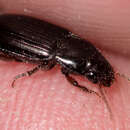Conservation Status
provided by University of Alberta Museums
Information not available.
- license
- cc-by-nc
- copyright
- University of Alberta Museums
Distribution
provided by University of Alberta Museums
It has a circumpolar distribution and is one of the early introduced species in North America from Europe. It is distributed globally and present in Europe, Asia Minor, Siberia and North America. In Canada, it is present in the provinces of Alberta, British Columbia, Saskatchewan, Manitoba, Ontario, Quebec, Nova Scotia, New Brunswick, Newfoundland, Northwest Territories, Yukon Territory and Prince Edward Island (CBIF, 2010, Lindroth, 1949). This species is widely distributed in Newfoundland (South, 1983).
- license
- cc-by-nc
- copyright
- University of Alberta Museums
General Description
provided by University of Alberta Museums
Adults are 6.5 - 9.0 mm in length. Adults are elongate, dark to brown with a faint bronze luster. Antennae, mouth parts and legs are reddish brown in colour. Eyes are convex and large. Prothorax is rounded with truncated anterior margins, sinuated at the base, hind angles denticulate. Elytra parallel-sided at middle with coarsely punctured striations which are notable at the base and flattened at the apex. Males with convex prosternum, hind tibiae bear brush like projections. Male genitalia smaller, convex at the base and straight at the apex, left margin protruded and hooks on lateral lobes rudimentary (Lindroth, 1968).
- license
- cc-by-nc
- copyright
- University of Alberta Museums
Habitat
provided by University of Alberta Museums
Occurs in most open types of habitats, dry areas with weedy patches or meadows are often favored. Also found in gardens, parks and courtyards (Lindroth, 1968).
- license
- cc-by-nc
- copyright
- University of Alberta Museums
Life Cycle
provided by University of Alberta Museums
No specific information is available on the biology of this species. Immature adults emerge in summer from June to July and emergence continues till August. Larvae mainly overwinter, however, sometimes adults overwinter too (Lindroth, 1968).
- license
- cc-by-nc
- copyright
- University of Alberta Museums
Trophic Strategy
provided by University of Alberta Museums
Larvae are mainly granivorous and feed on weed seeds (Lindroth, 1968). Adults are omnivorous and feed on eggs of root maggot flies (Diptera: Anthomyiidae) in vegetable crops such as cabbage (Prasad and Snider, 2006).
- license
- cc-by-nc
- copyright
- University of Alberta Museums
Amara apricaria
provided by wikipedia EN
- license
- cc-by-sa-3.0
- copyright
- Wikipedia authors and editors
Amara apricaria: Brief Summary
provided by wikipedia EN
Amara apricaria is a species of beetle of the genus Amara in the family Carabidae. It is native to Europe.
- license
- cc-by-sa-3.0
- copyright
- Wikipedia authors and editors

